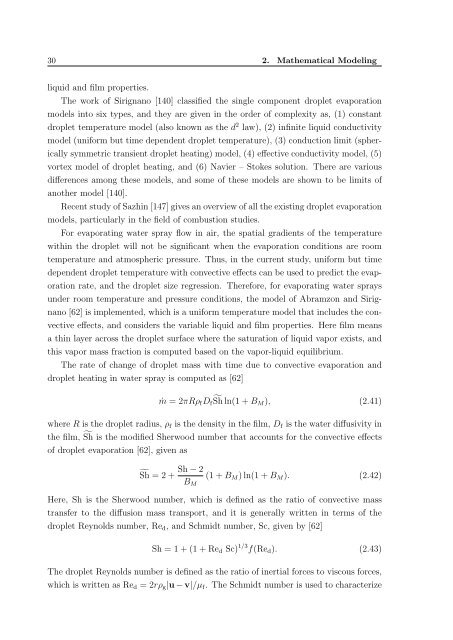INAUGURAL–DISSERTATION zur Erlangung der Doktorwürde der ...
INAUGURAL–DISSERTATION zur Erlangung der Doktorwürde der ...
INAUGURAL–DISSERTATION zur Erlangung der Doktorwürde der ...
You also want an ePaper? Increase the reach of your titles
YUMPU automatically turns print PDFs into web optimized ePapers that Google loves.
30 2. Mathematical Modeling<br />
liquid and film properties.<br />
The work of Sirignano [140] classified the single component droplet evaporation<br />
models into six types, and they are given in the or<strong>der</strong> of complexity as, (1) constant<br />
droplet temperature model (also known as the d 2 law), (2) infinite liquid conductivity<br />
model (uniform but time dependent droplet temperature), (3) conduction limit (spherically<br />
symmetric transient droplet heating) model, (4) effective conductivity model, (5)<br />
vortex model of droplet heating, and (6) Navier – Stokes solution. There are various<br />
differences among these models, and some of these models are shown to be limits of<br />
another model [140].<br />
Recent study of Sazhin [147] gives an overview of all the existing droplet evaporation<br />
models, particularly in the field of combustion studies.<br />
For evaporating water spray flow in air, the spatial gradients of the temperature<br />
within the droplet will not be significant when the evaporation conditions are room<br />
temperature and atmospheric pressure. Thus, in the current study, uniform but time<br />
dependent droplet temperature with convective effects can be used to predict the evaporation<br />
rate, and the droplet size regression. Therefore, for evaporating water sprays<br />
un<strong>der</strong> room temperature and pressure conditions, the model of Abramzon and Sirignano<br />
[62] is implemented, which is a uniform temperature model that includes the convective<br />
effects, and consi<strong>der</strong>s the variable liquid and film properties. Here film means<br />
a thin layer across the droplet surface where the saturation of liquid vapor exists, and<br />
this vapor mass fraction is computed based on the vapor-liquid equilibrium.<br />
The rate of change of droplet mass with time due to convective evaporation and<br />
droplet heating in water spray is computed as [62]<br />
ṁ = 2πRρ f D f ˜Sh ln(1 + BM ), (2.41)<br />
where R is the droplet radius, ρ f is the density in the film, D f is the water diffusivity in<br />
the film, ˜Sh is the modified Sherwood number that accounts for the convective effects<br />
of droplet evaporation [62], given as<br />
˜Sh = 2 + Sh − 2<br />
B M<br />
(1 + B M ) ln(1 + B M ). (2.42)<br />
Here, Sh is the Sherwood number, which is defined as the ratio of convective mass<br />
transfer to the diffusion mass transport, and it is generally written in terms of the<br />
droplet Reynolds number, Re d , and Schmidt number, Sc, given by [62]<br />
Sh = 1 + (1 + Re d Sc) 1/3 f(Re d ). (2.43)<br />
The droplet Reynolds number is defined as the ratio of inertial forces to viscous forces,<br />
which is written as Re d = 2rρ g |u − v|/µ f . The Schmidt number is used to characterize













